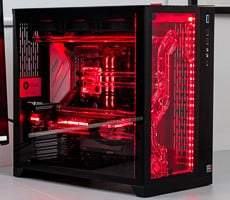Corsair Carbide 300R and Obsidian 550D Review
|
|
Warranty:
Dimensions: MB Support: Expansion Slots: Form Factor: Material: Drive Bays: Cooling: Front I/O: Power Supply: |
Two years 20.9” x 8.7” x 19.5” ATX, mATX 8 Mid-tower Steel structure with black brushed aluminum faceplate (x4) 5.25”, (x6) 3.5”/2.5” Drive Caddies (x6) 120/140mm Fans, (x2) 120mm Fans, Includes (x2) front-mounted 120mm fans and (x1) rear 120mm fan (x2) USB 3.0, (x1) Headphone, (x1) Mic ATX (not included) |
There are eight expansions slots, as well as plenty of room up top for a 240mm Hydra radiator if you want to go the liquid cooling route. If instead you prefer to stick with air cooling, the 550D has mounts for a total of eight fans--six 120mm/140mm and two 120mm. Two intake fans on the front of the case and one exhaust fan in the rear are included with the chassis.
The front I/O panel sports power and reset buttons, mic and headphone jacks, and a pair of USB 3.0 ports. There’s nothing too fancy there, but it has all the essentials--in particular, the USB 3.0 ports over USB 2.0 are most welcome. The I/O panel is gray in color with a metallic finish, which is a striking look against the dark brushed-metal front panel.
In terms of accessories, there are no surprises--just several bags of screws, zip ties, a USB 3.0 adapter, and some cable mounts. Let's go inside for a look around...






